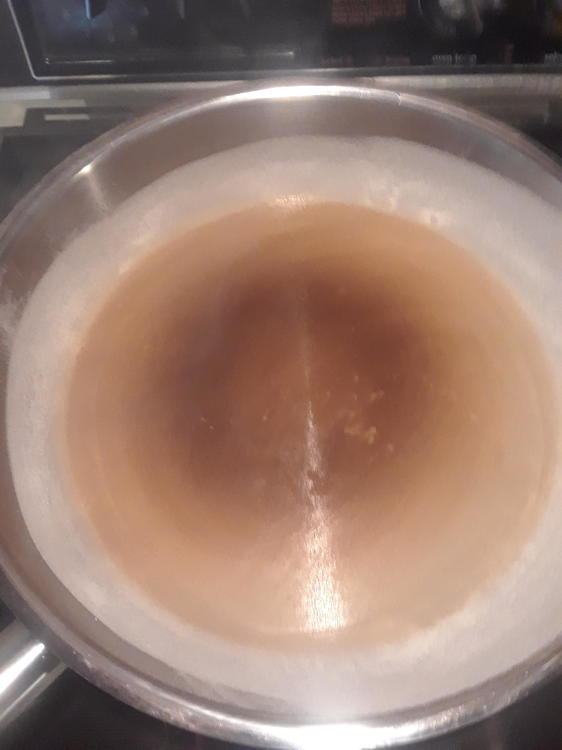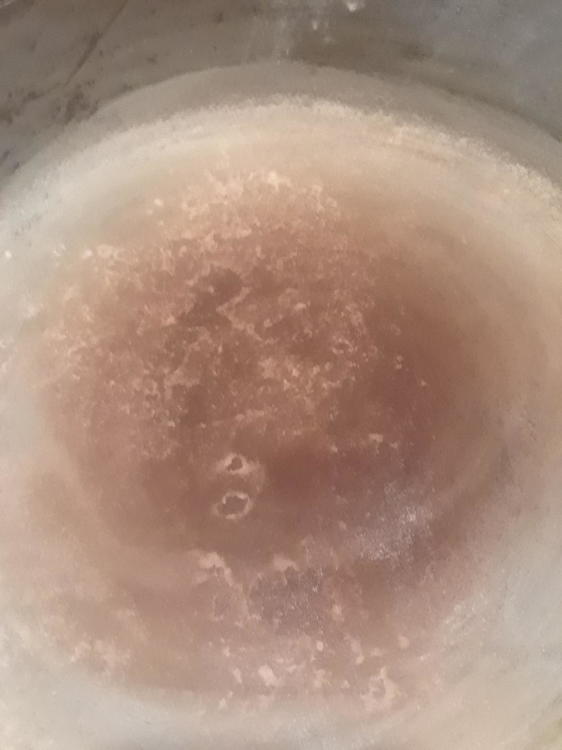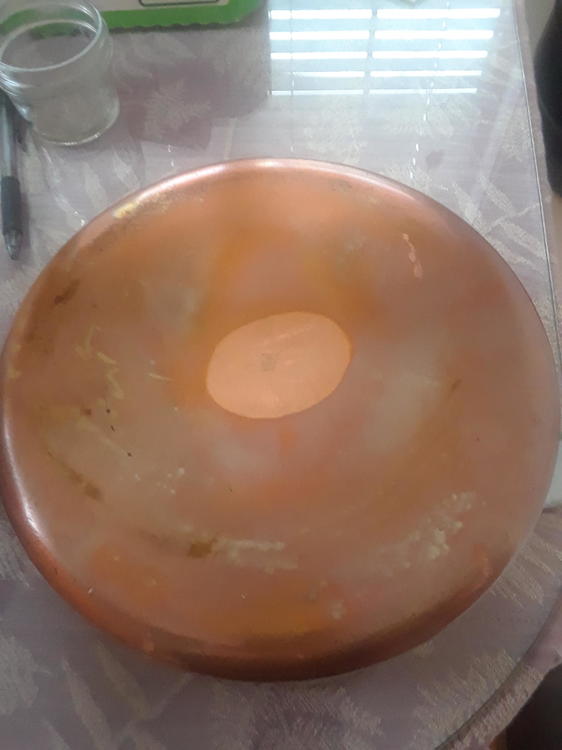
boilsover
participating member-
Posts
918 -
Joined
-
Last visited
Content Type
Profiles
Forums
Store
Help Articles
Everything posted by boilsover
-
If you would, please post a shot looking down at the spine. If it's thin to very thin, these clean up nice and make great "lasers" for slicing vegetables,
-
I did some time making knives, and grew up working in my dad's processing plant. I think this blade is worth restoring, but I humbly suggest you hire it out. Someone with the right belt machine and polishing setup would make short work of it. If you value your fingers and toes, do not put this anywhere close to a rotary buffer. You will get tired, the phone will ring, the edge will catch, and your finger will be on the floor before you feel it. Forget stones. If, however, you don't mind taking a lot of time, you can do the whole job, semi-safely, by hand. With a wooden pushstick and an assortment of emery cloth grits, you can put a mirror finish on the metal. It is laborious, but I've done it. You start off very coarse, and you run in one direction until you've removed all pits and scratches. Then you go just a tiny bit finer, and run at a 90° angle until all the first patten is removed. And so on until you're down to around 2000 grit automotive paper. If you want, I can post a photo of what the pushsticks look like, and offer more tips. You will earn it if you go this route. I think the whole process is written out in a book entitled "The $50 Knife Shop", by a guy named Wayne Goddard, IIRC.
-
No, it was the BSO. But thanks for the reminder to time my fullsize. [Edit #1] The fullsize electric oven took 7:35, but it probably would've been a bit shorter because: (a) that oven is in an unheated basement; and (b) the oven had a couple sheet pans stored in there. I'll run it again, but I'm guessing it would be more like 7:00 all things being equal. So, 5:00 for the BSO (Oh, and that probably was with the fan on) and 7:00 for the fullsize? The way I cook, apprx. 2 minutes' time savings isn't a powerful argument. Distance from the elements/positioning flexibility is more important to me. But I bought the BSO to serve as my only oven at the cabin, and it plays that role well. [Edit #2] OK, so starting from room temp and empty, my cheapo builder's grade coil range's oven preheats to 400F in 5:48. So I would save <1 minute in preheat time by choosing the BSO.
-
Thanks, that's useful.
-
You are remembering small electric box ovens with cooking hobs on top? I have one of the 1920s box ovens that sat atop a woodstove--the original smart oven.
-
Got links? Thanks.
-
Sorry, but buying, storing, retrieving and cleaning another unitasker, only to have to put it down and pick up the side towels or 'holders doesn't exactly fit my definition of 'convenient'.
-
Check the price for the Control Freak on Massdrop, too.
-
Hmmm, I just timed my 800XL Pro's (my third one, BTW) preheat time from room temp to 400F. It's almost exactly 5 minutes. I'll have to time my fullsize oven when I get back from the cabin,, but I don't think it takes a lot longer than that. I also find adjusting and withdrawing the racks (other than the middle one fitted with the magnet) to be a semi-hazardous PITA. And don't get me started about that funky thumbwheel mode knob or the long toast times.
-
That's all compatible. Oh, you won't starve... You can sear a steak with 1800W. But if, for instance, you want to cook 2 steaks in your carbon steel pan, the pan itself doesn't store nearly enough heat to do a good job of searing both sides--you will likely steam/grey the 2nd side. Full power hobs allow you to pump in a lot more heat at the flop. Most electric coil ranges are 2400W, and even they are iffy for searing.
-
Well, you would be saving energy the same way you save it with the oven. And you would have a fully portable alternative/auxillary to the range.. That surface is wasted as it is.
-
Well, assuming the unit is mounted low enough that the surface is at counter height, would you ind that a useful feature? I'm thinking, if people like using the BSO rather than firing their "real" oven, why not do the same with the hob?
-
I have been mulling a product idea for some time. What would be the interest of members here in owning a BSO-type counterrtop small oven combined with a very precise and even small cooktop built into the top housing surface? Worth having?
-
Two questions: (1) Do you have induction-compatible cookware now? (2) Can you get by without a full-power appliance? If you don't have compatible cookware already, you have to factor in that acquisition/discard cost, and you will ultimately have cookware you don't need. If you don't value your existing cookware, this may be no big deal. If you need a full-power appliance, you will probably be disappointed with a 110VAC/1800W unit like the Control Freak. Especially so because it costs $1700. You'd be paying a premium for extreme granularity, with the power of a toaster oven. IMO, the only reason to sink that long green is if you see a regular use for that kind of limited-power control after you move and again have access to a full-power appliance. Most people in that situation tide themselves over with a truly inexpensive (e.g., .<$150) induction hotplate with the same power, just fewer settings and no feedback. If you love your non-compatible cookware, but can see yourself using a single-hob induction appliance as a mainstay, I would consider investing in the Panasonic KY-Mk3500 Met-All that I reviewed here recently. It is a full 240VAC/3500W unit and "works" with non-magnetic cookware. It is likely a plug-in swap in your apartment (maybe with an adapter) for your dying electric range. I found mine for $611. It only has 20 settings, but that is actually a lot. Or, what about buying a cheap contractor-grade full-size range to tide you over? You can buy 2-3 of those for what you'd spend on the Control Freak. Tell your Sh&*bird landlord to come get his broken range for disposal, and you'll take yours with you.
-
Yes. There is really no Atlantic divide in terms of pan design. Everyone either bonds on a very thin ferromagnetic disk or makes the full outer layer of their clad from thin ferromagnetic steel. JoNorvelle has mentioned Fissler, which makes some of the best disk-base designs, as does Paderno (Italy) in their Grand Gourmet line; the Paderno is more restaurant-oriented and can sometimes be had on Euro eBay sites for shockingly little money. The conductive disks sandwiched between the pan body and the mnagnetowafer need to be quite thick to ameliorate that thermal "doughnut", like >6mm. As you might imagine, this strategy results in quite a slowing of these pans' responsiveness, so follow your needs. Demeyere is another top-flite Euro (Belgian/Zwilling German) mark, and somewhat unique in that they mix disk-base and clad constructions even within the same lines. I consider their Proline 5* skillets to be the best available. They innovate a lot (which is why I work with them). I believe no one else uses steel which is alloyed to manipulate the Curie Point, so the ContrilInduc pans will not overheat on induction. This is a fabulous feature for the aged, forgetful and those who know what PTFE pans can do when overheated. France's Sitram is getting back in the game In my opinion, the carbon steel fashion has very little to do with induction, although it works acceptably. The pans are used all over commercially because they are very cheap (far cheaper than Blu, MadeIn, and Daarto ask), easily replaceable, and here's the big boon--they season like a dream to nearly nonstick. Restaurants can afford stacks of them, and when single servings are fired on placques, there's no real concern about even heat.
-
Question Regarding Cooking Surfaces on a Cruise Ship
boilsover replied to a topic in Kitchen Consumer
Maybe, but my bet is that the controls are somewhere out of sight. -
Well, in a word, no. First, all of the action in a cooking appliance's induction field happens very near the surface nearest the Ceran. Past that "skin depth", it's just sluggish old steel left to (poorly) conduct heat. This is why those ferromagnetic bottom disks bonded onto pans of all sorts are exceedingly thin. The same thing happens with cast iron; it too is a poor conductor (but not as bad as steel)--anything below the skin depth is a waste, except for blunting the induced heat. Second, this is not conduction. Third, virtually all induction appliances rely on a single, central, doughnut-shaped coil. With a poor conductor like steel or iron, you can actually see the doughnut-shaped pattern of the coil translating a corresponding hotspot through the bottom of the pan. There isn't much problem moving the heat straight up (the distance is very small), but moving it laterally across the pan floor is harder when the material resists. Without conductive material to move the heat away, it exacerbates this halo effect, and even if you manage not to scorch the food, the heat will be uneven. It is not uncommon to have >50F differences between directly above the doughnut and further out near the wall. To counter this propensity, makers are incorporating very thick aluminum exterior disks or clad cores. "It's not the shiny stainless nickel/chrome steel that doesn't do magnetism..." I'm unsure of your meaning here, but both carbon steel and ferritic stainless steels "do magnetism". 400 Series stainless steels work just as well on induction as do carbon steels; that's what the makers use, and not just because carbon steel rusts. Induction may be considered awesome to cook on, but it's largely for reasons only indirectly bearing on cooking.
-
It's bad enough correcting common zombie cookware misconceptions. But when a legitimate food expert like Mark Bittman spouts complete nonsense about all tinned cookware containing lead, it's downright dismaying. Likewise when salespeople and companies tell that eternal doozer: "Cast iron heats evenly." The winner for 2019--so far--however, has to be Florence Fabricant, New York Times columnist and author of 12 cookbooks. In her January 22, 2019 issue of her column "Front Burner", Ms. Fabricant gushes over the carbon steel skillet made by Made In. Among other reasons to recommend it: "It’s a good conductor (it can be used on an induction cooktop) and has heft..." What? Surely Fabricant knows carbon steel, like any steel, is not only *not* a good conductor, it's a *terrible* one. In fact it's the worst metal pans are made of. If she doesn't, she needs to take a remedial physics course. And perhaps she was under a deadline to push this out, but what gives with the non sequitur explanatory parenthetical? Does she really believe that good conductivity and induction compatibility are the same or even closely related? Doubtless, someone, somewhere has already taken this nonsense for Gospel and spread it around. "Oh, boy! I can't wait for my new conductive steel skillet to be delivered!" Do you see, Larry? Do you see what happens when you make stuff up? https://www.nytimes.com/2019/01/22/dining/made-in-carbon-steel-skillet.html
-
I wish there was a better in-vogue word than 'artisanal'. It even sounds nasty. Are folks intentionally misspelling it to take the butt out -anal? Craft? Micro? Charcuter? Premium? How about "not total dreck"? One time I was driving through a small town, hungry, looking to grab a bite somewhere. In my windshield appears a roadhouse with one of those old grocery readerboards out front: "TODAY: 5TH ANAL CHILI COOKOFF" Mmmmmmmmm, pedal down...
-
Yard Sale, Thrift Store, Junk Heap Shopping (Part 3)
boilsover replied to a topic in Kitchen Consumer
The East Germans did some things very well. The Zeiss Jena optics being one example. The Stasi being another, but hey... -
OK, so here are the promised scorchprint photos on this induction unit. First the Fissler, then the Proline, then the 6mm aluminum, and then the 3.2mm tinned copper. As you can see, the "doughnut" is most pronounced in the clad and disk pans, and least pronounced in the aluminum and copper pans. I also thought I'd post an odd photo of the *bottom* of the Dehillerin--note how the heat discolored the copper outside the "doughnut hole" but left the copper bright *inside* it. All these photos are my own.
-
Hmmm, this might be worth having.
-
This, exactly. Canter's chief disservice was to suggest otherwise. The "drying oil" theme makes it appear to be a secret shortcut, but you just have to do your time. And flax oil tastes like okole...







